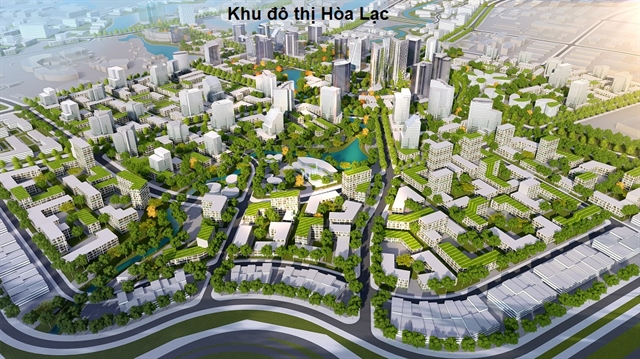 Society
Society


|
| A view of the planning of Hoà Lạc satellite urban area. — Photo gamudacityland.vn |
HÀ NỘI — Planning for five satellite urban areas in Hà Nội, which is expected to help reduce the overloading of the urban centre, lags behind schedule, the municipal Department of Planning and Architecture has said.
Nguyễn Trúc Anh, director of the department, said the city’s general planning included five zoning plans for satellite urban areas with a total area of more than 20,300 hectares, namely Hoà Lạc, Sơn Tây, Xuân Mai, Phú Xuyên and Sóc Sơn by 2030.
The satellite urban areas were hoped to develop in a complete manner from technical infrastructure to social infrastructure and reduce crowding and pollution in the urban centre.
However, only the planning of Hoà Lạc satellite urban area has been completed and approved by the Ministry of Construction. The planning will be submitted for the Government’s approval in the near future.
Sơn Tây and Sóc Sơn satellite urban areas were currently assigned to consultant units. Once completed, the planning would be handed over to the Hà Nội Urban Planning Institute.
In the first quarter of next year, the planning of Sóc Sơn urban area is expected to be reported. Phú Xuyên and Xuân Mai urban areas with six sub-projects were under construction for approval, he said.
Nguyễn Nguyên Quân of the city’s People’s Council said the city had aimed to complete the planning of the satellite urban areas in 2015, but the target had been missed.
He said it was necessary to assign responsibilities to those involved, especially the Department of Planning and Architecture which was the focal point for planning tasks and appraisal.
Due to the delay in satellite urban planning, the localities were currently facing difficulties in infrastructure construction as well as construction permits, he said.
In reply to Quân, Anh said the slow construction progress of satellite urban areas was due to the low capacity of the planning consultancy units, a shortage of input data for planning and the lengthened process of stakeholders' consultation.
For example, the planning of Sơn Tây satellite urban area consisting of six wards was assigned to T&T Group. However, due to the consulting unit's inability, the project has not been completed.
He suggested it was necessary to accelerate the process of digitising land data to serve planning work. In addition, local leaders needed to strictly follow the planning and supervision of individuals and organisations in the area.
According to the Government’s general planning in 2011, five satellite towns would be built in suburban areas of the city and could accommodate 1.4 million people, accounting for 15 per cent of the city’s population by 2030. — VNS




